Barbecue Techniques Every Man Should Master
Barbecue techniques offer a unique and enjoyable way to cook food, especially for men who have a passion for grilling and outdoor cooking. Mastering these techniques can elevate your culinary skills and make you a grill master among your friends and family. Here are some reasons why every man should strive to master barbecue techniques:
- Impress Friends and Family: By mastering barbecue techniques, you can create delicious and flavorful dishes that will impress your loved ones at gatherings and social events.
- Enjoy Delicious and Flavorful Food: Barbecue cooking infuses food with smoky and charred flavors, making it incredibly tasty and satisfying to eat.
- Connect with the Outdoors: Barbecuing allows you to spend quality time outside, enjoying nature, and embracing the outdoor cooking experience.
To become a successful barbecue expert, having the right tools and equipment is crucial. Essential barbecue tools include a grill or smoker, charcoal or propane for fuel, a BBQ thermometer for precise temperature control, and BBQ tongs and spatula for handling food safely.
There are various barbecuing techniques that you can master to diversify your culinary repertoire. These include direct grilling, indirect grilling, smoking, and rotisserie cooking. Each technique offers a unique flavor profile and cooking experience.

To truly master barbecue techniques, you should focus on certain aspects such as choosing the right cuts of meat, preparing and marinating the meat for optimal flavor, controlling fire temperature for consistent and even cooking, understanding cooking times and resting periods, and using flavorsome wood chips to enhance the taste of your dishes.
It’s important to be mindful of common barbecue mistakes and how to troubleshoot them. Avoiding flare-ups, preventing dry and overcooked meat, and managing uneven cooking are some of the challenges that you may encounter, but with the right knowledge and techniques, these mistakes can be avoided or fixed.
For barbecue enthusiasts looking to further enhance their skills and knowledge, there are plenty of additional resources available, such as cookbooks, online tutorials, and communities where you can connect with other barbecue enthusiasts.
By mastering barbecue techniques, you can elevate your cooking skills, create delicious meals, and enjoy the outdoor culinary experience. So, grab your apron, fire up the grill, and become the barbecue master you always wanted to be.
Key Takeaways:
- Impress Friends and Family: Mastering barbecue techniques allows you to showcase your skills and impress your loved ones with delicious and flavorful food.
- Enjoy Delicious and Flavorful Food: By mastering barbecue techniques, you can elevate the taste of your grilled dishes, making them more enjoyable and satisfying.
- Connect with the Outdoors: Barbecue techniques provide an opportunity to connect with nature and enjoy the outdoors while cooking and grilling.
Why Should Every Man Master Barbecue Techniques?
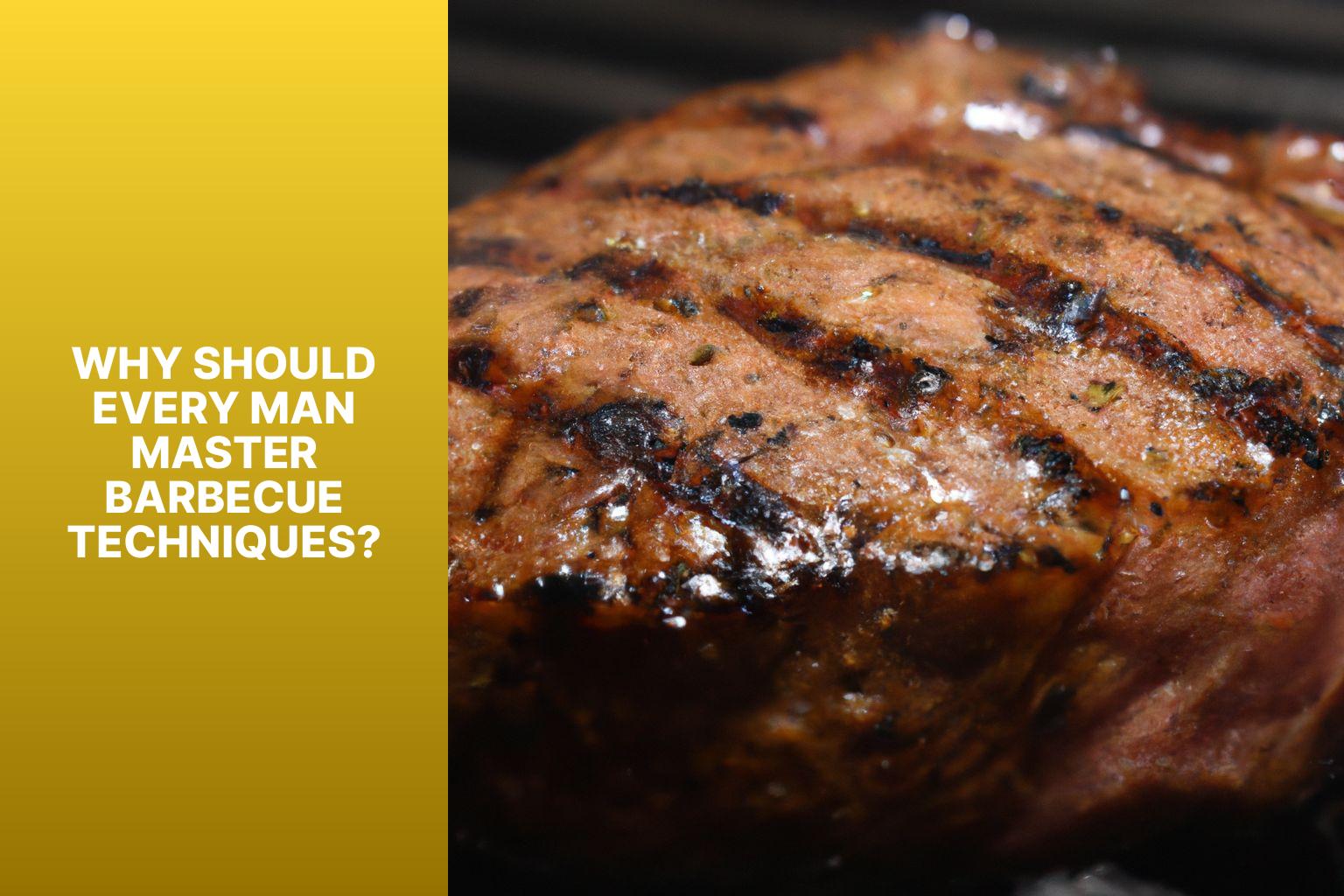
Photo Credits: Www.Moderngentlemanmagazine.Com by Philip Nguyen
Grilling season is upon us, and there’s no better time for men to master barbecue techniques. Get ready to wow your loved ones with mouthwatering dishes, savor the explosion of flavors, and embrace the great outdoors. So why should every man become a grill master? It’s simple: impress friends and family, indulge in delicious and flavor-packed meals, and build a deeper connection with the natural world. Get ready to ignite the fire and dive into the art of barbecuing!
1. Impress Friends and Family
Impressing loved ones is one reason to master barbecue techniques. Here are ways mastering barbecue techniques can impress your loved ones:
– Create delicious dishes: With the right techniques, you can cook flavorful food that will leave your loved ones craving for more. Your culinary skills will impress with perfectly grilled steaks and juicy burgers.
– Show off grilling expertise: When you demonstrate your ability to control fire temperature and create ideal cooking conditions, your loved ones will be amazed by your grilling expertise. Knowing the right cuts of meat, cooking times, and resting periods will showcase your knowledge and attention to detail.
– Create a welcoming atmosphere: Barbecuing brings people together and creates a welcoming environment. The enticing aroma of the food will invite your loved ones to gather around, creating memorable moments and strengthening relationships.
– Demonstrate dedication: Mastering barbecue techniques requires time, practice, and dedication. By investing in honing your skills, you demonstrate a commitment to excellence and a desire to provide the best dining experience for your loved ones.
– Become the go-to grill master: When you become proficient in barbecue techniques, your loved ones will turn to you for advice and assistance during their own outdoor cooking endeavors. Sharing your knowledge and helping others achieve great results will make you a true barbecue authority.
Impress your loved ones with your barbecue skills and create unforgettable gatherings filled with delicious food, laughter, and joy.
2. Enjoy Delicious and Flavorful Food
To enjoy delicious and flavorful food while barbecuing, consider the following:
1. Seasoning: Use herbs, spices, and marinades to enhance the meat’s flavor. Experiment with different combinations to suit your taste.
2. Quality ingredients: Start with high-quality cuts of meat, fresh vegetables, and other ingredients. The quality of the ingredients significantly impacts the final taste.
3. Cooking technique: Choose the appropriate technique for the type of food you’re grilling. Direct grilling is for smaller and thinner cuts that cook quickly, while indirect grilling is for larger cuts that cook slower and more evenly.
4. Temperature control: Maintain consistent temperatures to ensure even cooking and preserve flavors. Use a thermometer to monitor the meat’s internal temperature and avoid overcooking.
5. Wood chips: Use flavorful wood chips like hickory, mesquite, or applewood to add a smoky aroma and taste to your food. Soak the chips beforehand and place them on hot coals or in a smoker box to release smoke.
6. Resting: Allow the meat to rest after cooking to retain juices and enhance flavors. This resting period helps the meat reach ideal tenderness and juiciness.
7. Presentation: Consider the visual appeal of your dish. Garnish with fresh herbs, sliced fruits, or colorful vegetables to make it more appetizing.
By following these tips, you can enjoy delicious and flavorful food every time you barbecue, creating memorable dining experiences for you and your guests.
3. Connect with the Outdoors
Barbecuing offers the opportunity to connect with the outdoors and enhances the overall experience. Whether you’re grilling in your backyard, at a park, or camping, it allows you to immerse yourself in nature and find relaxation. It also provides an opportunity to gather with loved ones and create special memories.
Being outdoors while barbecuing has positive effects on well-being. Fresh air and sunlight boost mood and happiness, reduce stress, improve mental clarity, and increase creativity.
To truly connect with the outdoors, choose a suitable outdoor cooking spot and set up your grill or smoker there. Take the time to savor the sights, sounds, and smells of nature while you cook and enjoy your delicious barbecue creations.
Essential Barbecue Tools and Equipment
Looking to up your barbecue game? We’re diving into the world of essential barbecue tools and equipment. From the trusty grill/smoker to the debate between charcoal or propane, we’ll cover it all. Don’t forget about the BBQ thermometer and the all-important BBQ tongs and spatula. Get ready to equip yourself with the must-haves for your next backyard cookout.
1. Grill/Smoker

Photo Credits @trailfiregrill
Grill/Smoker: An essential tool for mastering barbecue techniques. When choosing the right grill/smoker, consider these factors:
- Type of grill/smoker: Charcoal, gas, electric, or pellet smokers. Choose one that suits your needs and preferences.
- Size and capacity: Consider cooking for large groups or limited space. Choose accordingly.
- Quality and durability: Look for high-quality, durable materials like stainless steel.
- Temperature control: Precise temperature control for different meats and recipes.
- Versatility: Some models offer rotisserie attachments and the ability to smoke different types of wood for added flavor.
By considering these factors, you can choose a grill/smoker that meets your specific needs. Thoroughly research different brands and models for the best choice in mastering barbecue techniques.
2. Charcoal or Propane

Photo Credits @trailfiregrill
When it comes to barbecuing, the choice between charcoal and propane as the fuel source is a key decision. Here are some important factors to consider:
1. Flavor: Charcoal grills provide a smoky flavor that is highly sought after by barbecue enthusiasts, creating the classic barbecue taste.
2. Convenience: Propane grills are known for their quick and easy preparation, with precise temperature control for adjusting the heat as needed.
3. Portability: Propane grills are generally more portable than charcoal grills, equipped with wheels for easy movement in outdoor spaces or on camping trips.
4. Availability: Propane is widely available for refilling or replacement, while charcoal requires planning ahead for purchasing and storage.
Ultimately, your choice between charcoal and propane depends on personal preferences and barbecuing needs. If you value the traditional smoky flavor and are willing to put in the extra effort, charcoal may be the way to go. If convenience and precise temperature control are important to you, propane might be the better option.
3. BBQ Thermometer
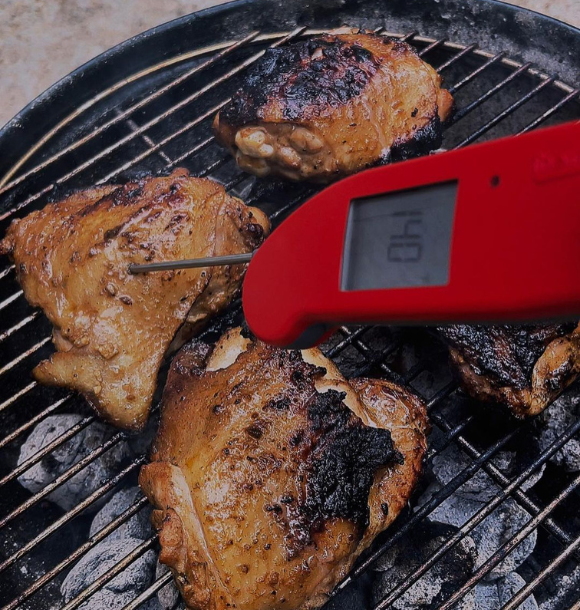
Photo Credits @smokepointq
A BBQ thermometer is an essential tool for grilling enthusiasts. It ensures that your meats are cooked perfectly and safe to eat. Here is some important information about BBQ thermometers:
| Type of BBQ Thermometer | Temperature Range | Accuracy | Key Features |
| Instant-read Thermometer | -40°F to 572°F (-40°C to 300°C) | ±1-2°F (±0.5-1°C) | – Provides quick temperature readings |
| Probe Thermometer | 32°F to 482°F (0°C to 250°C) | ±1-2°F (±0.5-1°C) | – Allows continuous monitoring of the meat’s internal temperature |
| Wireless Thermometer | 32°F to 572°F (0°C to 300°C) | ±1-2°F (±0.5-1°C) | – Allows temperature monitoring from a distance |
A reliable BBQ thermometer is crucial for grilling steaks, smoking ribs, or cooking a whole chicken. It ensures that your meats are cooked perfectly, avoiding undercooked or overcooked results. Follow the manufacturer’s instructions for proper use and calibration to achieve accurate readings. With a BBQ thermometer, you can create delicious and flavorful barbecued dishes with confidence.
4. BBQ Tongs and Spatula
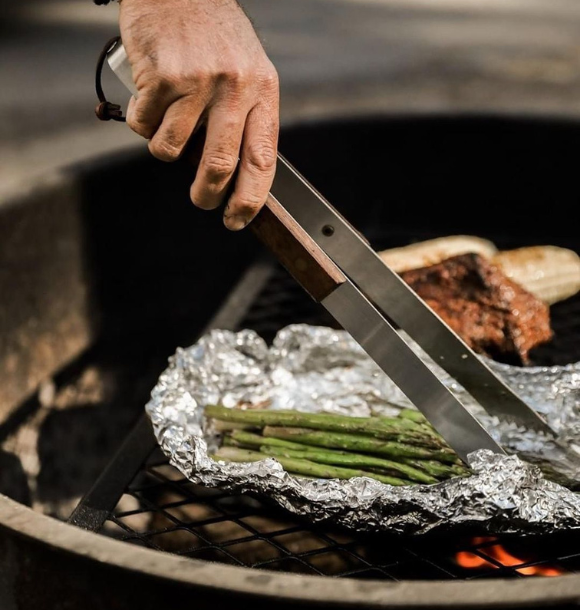
Photo Credits @lamsoncutlery
When it comes to barbecuing, having the right tools is essential. Here are some important considerations for choosing the best BBQ tongs and spatula:
- Material: It is important to choose BBQ tongs and spatulas made of stainless steel for durability, heat-resistance, and easy cleaning. They can withstand the high grill temperatures without warping or melting.
- Length: Opt for longer BBQ tongs and spatulas, around 16 to 18 inches, to keep your hands safe from the heat while reaching all areas of the grill.
- Grip: Make sure to ensure a comfortable and non-slip grip for better control and to prevent accidents while handling hot and heavy foods.
- Locking Mechanism: It is recommended to look for BBQ tongs with an easy storage locking mechanism to keep your kitchen organized and prevent accidents.
- Versatility: Choose BBQ tongs and spatulas with additional features like a built-in bottle opener or serrated edge for opening bottles or cutting into meats or vegetables while grilling.
By considering these factors, you can find the perfect BBQ tongs and spatula to enhance your grilling experience and achieve delicious and perfectly cooked meals.
Types of Barbecuing Techniques
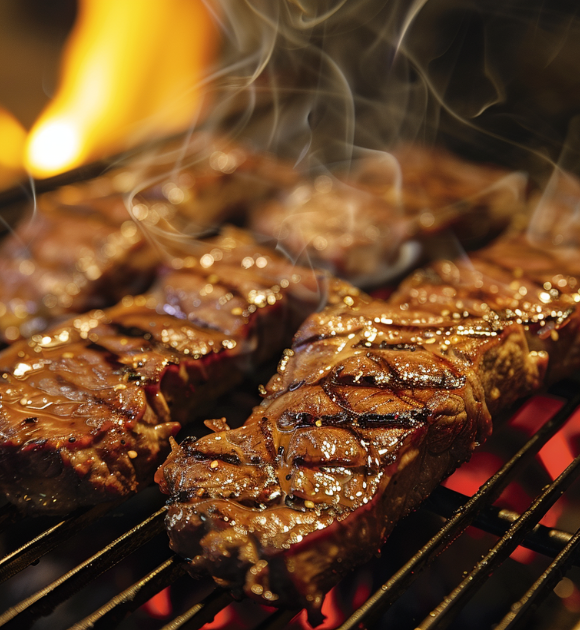
When it comes to mastering the art of barbecuing, there’s a world of techniques waiting to be explored. In this section, we’ll uncover the different types of barbecuing techniques that will take your grill game to the next level. From the sizzling delights of direct grilling to the slow, smoky wonders of smoking, and even the mouthwatering perfection achieved with rotisserie cooking – get ready to dive into the secret techniques that will turn you into a barbecue maestro.
1. Direct Grilling
Direct grilling is a popular barbecue technique that involves cooking food directly over the heat source. To successfully achieve this cooking method, follow these steps:
1. Preheat the grill: It is important to preheat the grill to the desired temperature in order to ensure even cooking and prevent sticking.
2. Prepare the food: Before placing the food on the grill, season it with spices and marinades. Make sure the food is at room temperature.
3. Oil the grill grates: To prevent sticking, lightly oil the grill grates using a brush or an oil-soaked paper towel.
4. Place the food on the grill: Carefully place the food directly over the heat source while keeping the lid open. It is essential to monitor the food to prevent burning.
5. Flip the food: After a few minutes, depending on the thickness of the food, use tongs or a spatula to flip it. Make sure to cook both sides evenly.
6. Monitor the temperature: Use a BBQ thermometer to check the internal temperature of the food. This will help determine if it is cooked to the desired level.
7. Remove from the grill: Once the food reaches the desired temperature, remove it from the grill and let it rest for a few minutes before serving.
Direct grilling is a versatile technique that works well for steaks, burgers, and vegetables. It allows for direct contact with the heat, resulting in a delicious charred exterior and juicy interior. By following these steps, you can achieve perfect results using the direct grilling method.
2. Indirect Grilling
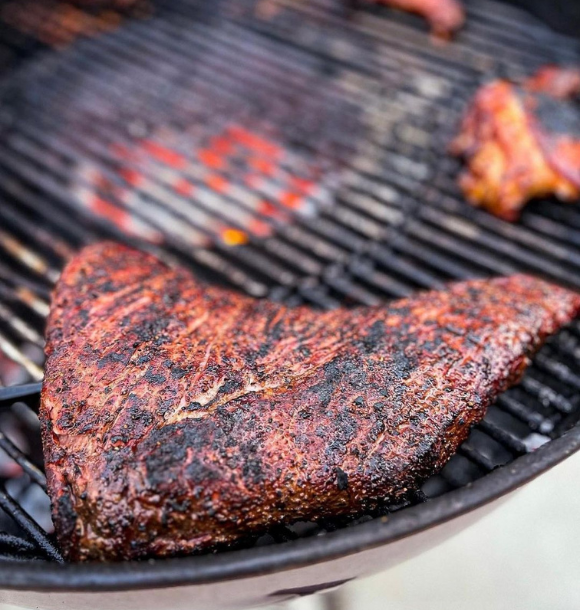
Photo Credits @fogocharcoal
Indirect grilling, also known as the two-zone fire method, is an excellent technique for achieving slow and even cooking on the barbecue. It is particularly well-suited for cooking large cuts of meat, including roasts and whole poultry, as well as delicate foods that are prone to burning.
To become a master of indirect grilling, follow these simple steps:
- Begin by preheating your grill to the desired temperature, typically around 225-250°F (107-121°C).
- Create a two-zone fire by dividing your grill into two distinct areas: one for direct heat and one for indirect heat. Position your charcoal or burners on one side, leaving the other side empty for indirect heat cooking.
- On the empty side of the grill, place a drip pan filled with water or marinade. This will catch any drippings and help prevent flare-ups.
- Soak your wood chips in water for approximately 30 minutes, then drain them. You can either place the wood chips directly on the charcoal or create a foil packet and place it on the burner. This will infuse your food with delicious smoky flavors.
- Season your food with your preferred spices, rubs, or marinades. If you’re grilling large cuts of meat, be sure to allow them to come to room temperature before placing them on the grill.
- Position your food on the grill grates above the drip pan, on the side without direct heat. Close the lid to maintain the heat and create a convection cooking environment, resulting in slow and even cooking.
- To ensure your food is cooked to perfection, use a barbecue thermometer to monitor its internal temperature. Insert the thermometer probe into the thickest part of the meat, avoiding bones or fat.
- Periodically baste your food with barbecue sauce or another flavorful liquid to keep it moist and enhance its taste.
- Once your food reaches its target temperature, carefully remove it from the grill and allow it to rest for a few minutes. This allows the juices to redistribute, resulting in tender and succulent meats.
By mastering the art of indirect grilling, you can create impressive barbecue dishes with tender meats and perfectly cooked delicate foods. Remember to prioritize safety and adhere to proper cooking temperatures for delicious and safe results.
3. Smoking
Edited
| 3. Smoking |
| Smoking meat adds unique and delicious flavor to food. |
| During smoking, meat is cooked slowly over indirect heat and flavored with smoke from wood chips or chunks. |
| Consider these key aspects when smoking meat: |
| 1. Wood selection: Different woods impart different flavors. For example, hickory wood provides a strong taste, while fruit woods like apple or cherry add a sweeter flavor. |
| 2. Temperature control: Maintain a consistent temperature between 225°F and 250°F (107°C and 121°C) for most cuts of meat. |
| 3. Smoking time: Smoking time varies based on meat type and size. Plan for approximately 1-2 hours of smoking time per pound (0.45-0.9 kg) of meat. |
| 4. Smoke production: To enhance smoke flavor, add wood chips or chunks periodically throughout the smoking process. Soak the wood chips in water for about 30 minutes before adding them to the fire to create more smoke. |
| 5. Meat preparation: Before smoking, prepare the meat with a dry rub or marinade to enhance flavor and create a tasty crust on the outside. |
4. Rotisserie
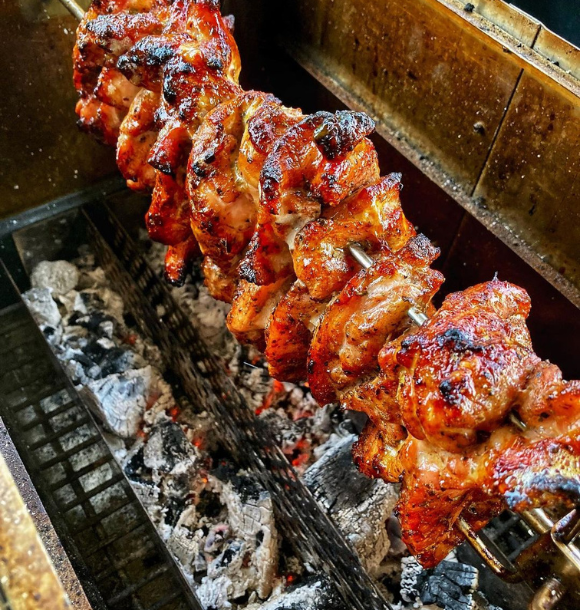
Photo Credits @quetensils
The rotisserie method is a popular barbecue technique that involves skewering meat on a rotating spit or rod to evenly cook it over an open flame or heat source. This method ensures even cooking by rotating the meat and prevents overcooked or undercooked sections. It also helps to baste the meat in its own juices, resulting in juicier and more tender cuts. The slow cooking process enhances the flavor by allowing the marinade or seasoning to penetrate the meat, giving it a rich and delicious taste. The rotisserie method also promotes the development of a crispy and caramelized exterior, adding texture and depth to the meat.
| Benefits of Using a Rotisserie: |
| 1. Even Cooking: The constant rotation of the meat ensures that it cooks evenly on all sides. |
| 2. Juicier Meats: The rotation helps to baste the meat in its own juices, resulting in moist and tender cuts. |
| 3. Enhanced Flavor: The slow cooking process allows the flavors of the marinade or seasoning to penetrate the meat. |
| 4. Crispy Exterior: The rotisserie method promotes the development of a crispy and caramelized exterior. |
To use a rotisserie, you need a grill or smoker with a rotisserie attachment. Secure the meat onto the spit, making sure it is balanced and properly secured. Place the spit onto the rotisserie attachment and start the cooking process. Monitor the temperature and adjust the heat as needed. Once the meat reaches the desired doneness, remove it from the spit and let it rest before carving.
The rotisserie technique is versatile and can be used to cook a variety of meats, such as whole chickens, roasts, and even whole animals like pigs. It is a great way to impress guests at gatherings and enjoy succulent and flavorful barbecue.
Mastering Barbecue Techniques

Photo Credits @honeybrixbbq
Become a barbecue virtuoso as we dive into the world of mastering barbecue techniques. From selecting the finest cuts of meat to achieving the perfect fire temperature and control, we’ll cover it all. Get ready to marinate like a pro and understand the art of cooking times and resting periods. Plus, we’ll explore the delightful addition of flavorful wood chips to elevate your barbecue game to new heights. Get your apron on and let’s master the grill!
1. Choosing the Right Cuts of Meat
To choose the right cuts of meat for barbecue, consider tenderness, flavor, and cook time. Here is a table of popular cuts and their characteristics:
| Cut of Meat | Tenderness | Flavor | Cook Time |
|---|---|---|---|
| Ribeye | Tender | Rich and juicy | Medium to high |
| Pork Shoulder | Tender when cooked low and slow | Rich and fatty | Long and slow |
| Brisket | Tough when cooked quickly, but tender when cooked low and slow | Rich and smoky | Long and slow |
| Chicken Thighs | Tender and juicy | Mild and flavorful | Medium |
| Salmon | Delicate and flaky | Buttery and mild | Short to medium |
When choosing cuts of meat, consider tenderness. Tender cuts like ribeye and chicken thighs are perfect for quick grilling. For slow-smoked meats, opt for tougher cuts like pork shoulder and brisket, which become tender and flavorful when cooked low and slow. The flavor profile of the meat is also important, with ribeye and pork shoulder offering rich and juicy flavors, while salmon provides a buttery and mild taste. Cooking time varies depending on the cut, with shorter cook times for salmon and medium cook times for chicken thighs. Pork shoulder and brisket require longer cooking periods for optimal tenderness. By considering these factors, you can confidently choose the right cuts of meat for your next barbecue.
2. Preparing and Marinading the Meat
When preparing meat for barbecue, it is important to follow these steps to enhance flavor and tenderness. First, choose cuts suitable for grilling, such as ribeye, sirloin, or chicken thighs, which are known for their tenderness and grilling ability. Next, tenderize tougher cuts with a meat mallet to ensure they become tender on the grill.
After tenderizing, it is time to season the meat. Generously season both sides of the meat with salt and pepper for added flavor.
To further enhance the taste, create a marinade using soy sauce, lemon juice, garlic, and herbs. Make sure to fully coat the meat with the marinade and refrigerate it for at least 30 minutes. The recommended marinating time will vary depending on the type and thickness of the meat.
Before grilling, it is important to remove any excess marinade to prevent flare-ups on the grill. Let the marinated meat sit at room temperature for 15-30 minutes to ensure even cooking.
By following these steps, your meat will be flavorful, tender, and perfectly prepared for the barbecue.
3. Perfecting the Fire Temperature and Control
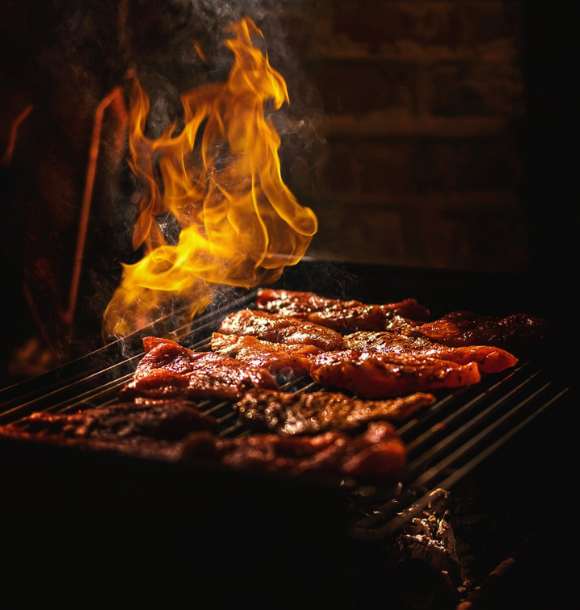
Photo Credits @honeybrixbbq
When it comes to perfecting the fire temperature and control in barbecue, follow these steps:
- Clean your grill or smoker to remove any ash or debris for consistent heat.
- Choose the right fuel, charcoal or propane, based on your preferences. Charcoal adds smoky flavor, but takes more time and effort to light and control temperature. Propane offers convenience and precise temperature control.
- Light your grill or smoker evenly using a chimney starter or propane lighter to avoid hot spots and ensure even cooking.
- Allow the fire to reach the desired temperature and use a BBQ thermometer to monitor and adjust. For low and slow cooking, aim for 225-275°F (107-135°C). For hot and fast grilling, 350-450°F (177-232°C) works best.
- Control the temperature by adjusting the airflow. Open vents for higher heat and close them for lower heat.
- Maintain a consistent temperature by adding more fuel and adjusting the airflow as needed.
- Soak wood chips in water for 30 minutes before adding them to regulate the burn and prevent excessive smoke.
- Regularly monitor the temperature with a BBQ thermometer and make necessary adjustments.
By following these steps, you can achieve precise control over the fire temperature during your barbecue and create delicious, perfectly cooked dishes.
4. Understanding Cooking Times and Resting Periods
When it comes to barbecue, understanding cooking times and resting periods is essential for achieving perfectly cooked and flavorful meat. Here are the steps to follow:
1. Prep the meat: Before cooking, make sure to bring the meat to room temperature to ensure even cooking.
2. Season the meat: Enhance the flavor by applying marinade or rub. Allow it to sit for the recommended time.
3. Preheat the grill: Start preheating the grill to the desired temperature according to your recipe or the type of meat being cooked.
4. Cook the meat: Place the meat on the grill and cook it according to the recommended times for the specific cut and thickness. Avoid constant flipping to prevent delays.
5. Use a thermometer: To ensure accurate readings, check the internal temperature of the meat using a BBQ thermometer. Follow a reliable guide for reference.
6. Rest the meat: After reaching the desired internal temperature, remove the meat from the grill. Let it rest for a few minutes, allowing the juices to redistribute and resulting in tender and juicy meat.
7. Slice and serve: After resting, slice the meat against the grain and serve immediately while it’s still hot.
Understanding cooking times and resting periods guarantees that your barbecue meals are cooked to perfection, resulting in delicious and flavorful meat. Always adhere to safe cooking temperatures and adjust times accordingly based on the specific type of meat being cooked. Happy barbecuing!
5. Using Flavorful Wood Chips
When it comes to barbecue techniques, using flavorful wood chips can enhance the taste and aroma of grilled or smoked dishes. Here are some important points to consider:
Choose the Right Wood Chips: Different types of wood chips impart various flavors to the meat. For a mild, versatile smoky flavor, opt for fruitwood chips like apple or cherry. For a stronger taste, try mesquite or hickory wood chips.
Soak the Wood Chips: Soak the wood chips in water for about 30 minutes to slow down the burn rate and produce steady smoke. This adds moisture, allowing the chips to smolder and produce flavorful smoke.
Use Indirect Grilling: Place the soaked wood chips in a smoker box or wrap them in aluminum foil with a few holes. Position the wood chips near the heat source but not directly over it to avoid flare-ups. This method allows the smoke to envelop the meat and infuse it with the wood’s flavors.
Control the Smoke: Adjust the amount of smoke by adding or reducing the chips during cooking. Light smoke enhances the flavor, while excessive smoke can overpower the meat.
Experiment with Different Wood Varieties: Try oak, pecan, or whiskey barrel chips to create unique flavor profiles.
By using flavorful wood chips, you can add a smoky essence to your barbecue dishes, enhancing the taste and creating a memorable dining experience.
Troubleshooting Common Barbecue Mistakes
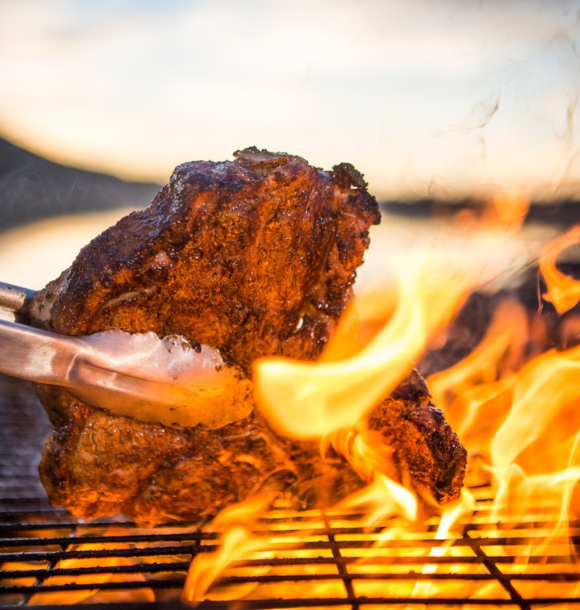
Photo Credits @honeybrixbbq
Are your barbecues not turning out as mouthwatering and delicious as you hoped? Don’t worry, we’ve got you covered! In this section, we’ll tackle the art of troubleshooting common barbecue mistakes. Whether you’re dealing with pesky flare-ups, dry and overcooked meat, or uneven cooking, we’ll provide you with practical tips and techniques to save the day. Get ready to impress your friends and family with flawless barbecues that will make you the grill master in no time!
1. Avoiding Flare-ups
Avoiding flare-ups while barbecuing is essential for maintaining control over your cooking and preventing your food from getting burned. To minimize flare-ups, follow these steps:
1. Trim excess fat from the meat: Removing excess fat reduces the risk of flare-ups caused by fat dripping onto the fire.
2. Choose leaner cuts of meat: Opt for leaner cuts to minimize the amount of fat that drips onto the fire.
3. Maintain a safe distance: Position the food on the grill away from direct flames. You can achieve this by using indirect grilling methods or placing a drip pan between the coals and the food.
4. Use lighter marinades: Avoid marinades with sugary or oily ingredients to reduce flare-up chances. Opt for lighter marinades with minimal sugars and oils.
5. Control the fire: Keep a close eye on the fire and maintain a consistent temperature. Flare-ups can happen due to excessive heat or fat accumulation. Adjust the airflow and food position to control the fire.
6. Have a spray bottle of water nearby: If flare-ups do occur, quickly spray the flames with water to control them. Be cautious and avoid spraying directly onto the coals.
By following these steps, you can minimize the risk of flare-ups and ensure successful barbecue cooking.
2. Preventing Dry and Overcooked Meat
– Choose cuts of meat with higher fat content and marbling for juicier results.
– Use marinades or brines for moisture retention and enhanced flavor.
– Monitor the internal temperature of the meat using a reliable meat thermometer.
– Prevent dryness by using the indirect grilling method for larger cuts of meat.
– Allow the meat to rest after cooking to redistribute juices and enhance flavor.
– Avoid excessive flipping or piercing that can cause juices to escape.
– Control the heat and avoid cooking over high heat for extended periods.
3. Managing Uneven Cooking
1. Use a two-zone fire setup: To manage uneven cooking, create a high-heat zone and a low-heat zone on your grill by piling charcoal on one side. This technique allows you to move the food between the two zones based on the level of heat it needs.
2. Adjust the grill grates: If you notice that one side of your grill is hotter than the other, you can shift the position of the grill grates to even out the heat distribution. This simple adjustment can effectively prevent uneven cooking.
3. Utilize indirect grilling: In order to ensure even cooking, especially for larger cuts of meat or delicate items, it is recommended to make use of indirect grilling. By placing the food on the cooler side of the grill and closing the lid, you allow the heat to circulate evenly, resulting in perfectly cooked food.
4. Rotate and flip the food: Another technique to achieve even cooking is to periodically rotate and flip the food on the grill. This helps promote even cooking on all sides and prevents a situation where one side of the food browns or cooks more than the other.
5. Use a meat thermometer: To maintain consistent internal temperatures and avoid uneven cooking, it is advisable to use a meat thermometer. Inserting the thermometer into different areas of the meat allows you to check for doneness and ensure that the food is cooked to perfection.
6. Modify cooking times: Managing uneven cooking can also involve adjusting cooking times based on the thickness or size of the food. Thicker cuts may require more time on the grill to ensure even cooking throughout.
7. Rest the meat: After cooking, it is important to allow the meat to rest for a few minutes. This step helps redistribute the juices and ensures that the texture of the food remains consistent throughout.
By properly managing uneven cooking on the grill using these techniques, you can effortlessly achieve delicious and evenly cooked meals every time you barbecue.
Additional Resources for Barbecue Enthusiasts
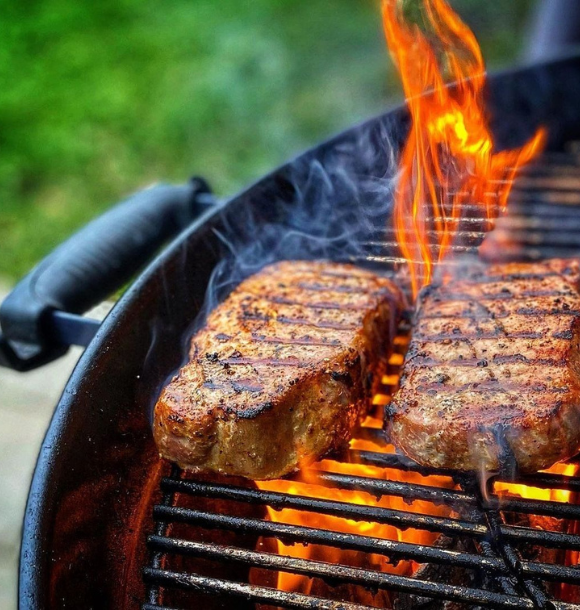
Photo Credits @webergrillsca
For barbecue enthusiasts, having additional resources can greatly enhance their skills and knowledge in the art of barbecue. There are several valuable sources available that provide information and guidance. These additional resources include online forums, books, YouTube channels, barbecue classes, barbecue competitions, and barbecue blogs and websites.
Online forums are a great way to connect with a community of like-minded individuals who share tips, recipes, and experiences. Joining online barbecue forums such as BBQ Brethren and The BBQ Pit Boys allows you to engage with experienced pitmasters and learn from their expertise.
Books are another fantastic resource for barbecue enthusiasts. Excellent barbecue cookbooks such as “Franklin Barbecue: A Meat-Smoking Manifesto” by Aaron Franklin and “Meathead: The Science of Great Barbecue and Grilling” by Meathead Goldwyn provide detailed instructions, recipes, and techniques to help you improve your barbecue skills.
YouTube channels dedicated to barbecue also offer a wealth of resources. These channels provide instructional videos, demonstrations, and recipe ideas. BBQ Pit Boys and Tasty are just a few examples of YouTube channels that offer a plethora of content for barbecue enthusiasts.
Attending barbecue classes or workshops can be a great hands-on learning experience. Many barbecue restaurants and organizations offer classes where you can learn from professional pitmasters and gain valuable insights to take your barbecue game to the next level.
Participating in or attending barbecue competitions is another excellent way to expand your knowledge and skills. These competitions expose you to a wide range of barbecue techniques and styles, allowing you to observe and learn from experienced competitors. It’s a great source of inspiration for your own barbecue journey.
Barbecue blogs and websites dedicated to barbecue are reliable sources of information, recipes, and tips. BBQ Pit Boys, AmazingRibs, and SmokingPit are just a few examples of reputable resources that provide valuable content for barbecue enthusiasts.
Frequently Asked Questions
How do I ensure my grill is hot enough for cooking?
Preheating the grill is important to achieve a good sear on the food and kill bacteria. Different temperatures are suitable for different types of food. Start by lighting the grill and letting it heat up for the recommended time according to the grilling guide.
What is the best way to clean grill grates?
To keep your grates clean, it’s important to clean the grill before and after each use. Use a grill brush or balled-up foil to remove residue, ensuring flavors don’t mix and food doesn’t stick.
How do I prevent meat from sticking to the grill?
To prevent lean meats from sticking to the grill grates, rub oil on the grates using a paper towel or use non-stick grill-safe foil before cooking. This will create a non-stick surface.
Is it necessary to let meat rest after grilling?
Yes, letting meat rest for a few minutes before slicing is important as it allows the juices to redistribute, resulting in a juicier and more tender piece of meat. Tent the meat with foil to keep it warm during the resting period.
What are some food safety guidelines for grilling?
Ensure food safety by following these guidelines: use separate cutting boards and utensils for raw and cooked foods, refrigerate meat while marinating, and avoid basting with marinating liquid to prevent cross-contamination.
Should I cook foods directly or indirectly on the grill?
For smaller pieces of meat, it’s best to cook directly over the heat source. For larger pieces, it’s recommended to cook indirectly. Indirect grilling involves heating only one side of the grill and cooking the meat on the unheated side to achieve more even cooking.
